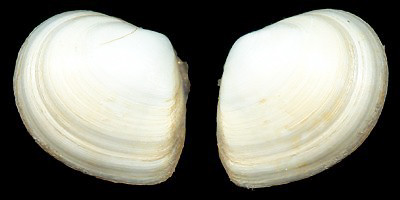Macoma Clams
Macoma spp.
Macoma clams are tiny bivalves with thin, chalky white shells. They live buried in the sand or mud in the shallow waters of the middle and lower Chesapeake Bay.
This section shows one large critter image at a time. Use the thumbnails that follow to select a specific image to display here.

This gallery contains a grid of small thumbnails. Selecting a thumbnail will change the main image in the preceding section.
Appearance
Two species of macoma clams can be found in the Chesapeake Bay:
- The Baltic macoma clam, Macoma balthica
- The narrowed macoma clam, Macoma tenta.
Macoma clams have thin, fragile shells. They have two long, thin, flexible siphons (one of which is longer than the other) that can be pulled completely inside their shells. They also have a hatchet-shaped foot. The Baltic macoma clam has broad, oval-shaped shells, sometimes with a pinkish tint.
The narrowed macoma clam’s shells are longer than the Baltic macoma’s and have a smooth, pearly sheen. The narrowed back end of the shell is slightly twisted to the left. The Baltic macoma clam is the larger of the two species, growing to 1.5 inches in length, while the narrowed macoma clam only grows to three-quarters of an inch in length.
Feeding
While buried in the sand, the clam’s two siphons stick up above the surface. The longer siphon sucks in tiny bits of food lying on the Bay’s bottom. It can also draw in water and filter out plankton. Waste and unused water are ejected through the other siphon.
Predators
Macoma clams’ long siphons look like worms crawling along the bottom. They attract many predators, including American eels.
Reproduction and life cycle
Macoma clams release eggs and sperm into the water column. After being fertilized, eggs develop into larvae with two tiny, transparent shells and a small foot. Larvae float in the currents for a few weeks before eventually settling to the bottom. To avoid being tossed around by waves, larvae anchor themselves to sand grains using thin threads secreted from a gland on their foot.
Did you know?
- Even though they are not as well-known as hard clams or soft shell clams, macoma clams are some of the most abundant clams in the Bay.
- Macoma clams are able to shift positions while buried in the sand. When disturbed, they will quickly burrow deeper.
Sources and additional information
- Life in the Chesapeake Bay by Alice Jane Lippson and Robert L. Lippson
- Chesapeake Bay: Nature of the Estuary, A Field Guide by Christopher P. White
- Macoma balthica – Encyclopedia of Life
